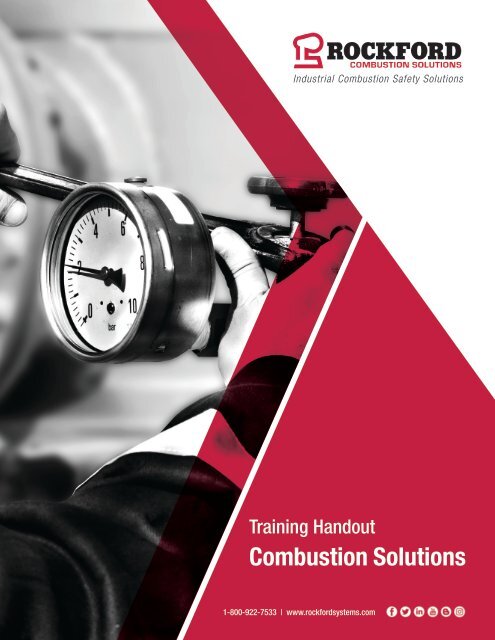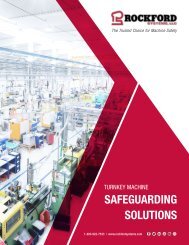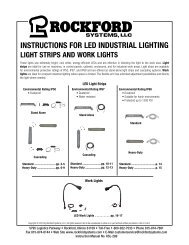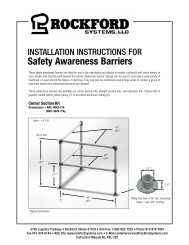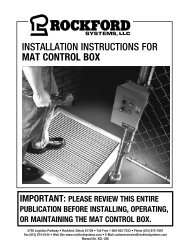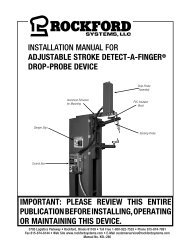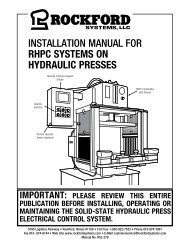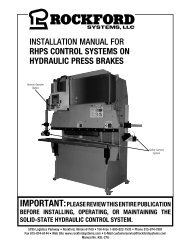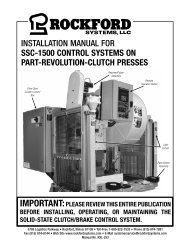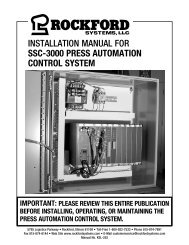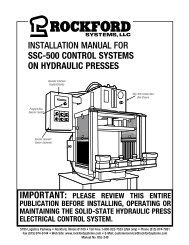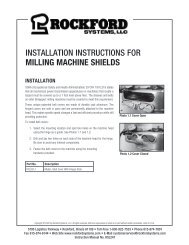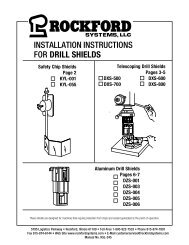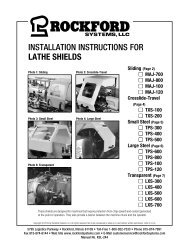Rockford Combustion Solutions Training Handouts
- No tags were found...
You also want an ePaper? Increase the reach of your titles
YUMPU automatically turns print PDFs into web optimized ePapers that Google loves.
Industrial <strong>Combustion</strong> Safety <strong>Solutions</strong><br />
<strong>Training</strong> Handout<br />
<strong>Combustion</strong> <strong>Solutions</strong><br />
1-800-922-7533 | www.rockfordsystems.com
NFPA 85 (2019 EDITION) – BOILER AND COMBUSTION SYSTEMS HAZARD CODE<br />
4.4.3.1<br />
Operator <strong>Training</strong><br />
4.4.3.2<br />
Maintenance <strong>Training</strong><br />
4.4.3.1.1<br />
4.4.3.1.2<br />
4.4.3.1.2.1<br />
4.4.3.1.2.2<br />
4.4.3.1.2.3<br />
4.4.3.1.3<br />
The owner or the owner’s representative shall<br />
be responsible for establishing a formal training<br />
program that is consistent with the type of<br />
equipment and hazards involved to prepare<br />
personnel to operate equipment.<br />
Operating procedures shall be established that<br />
cover normal and emergency conditions.<br />
Start-up, shutdown, and lockout procedures<br />
shall all be covered in detail.<br />
Where different modes of operation are<br />
possible, procedures shall be prepared for each<br />
operating mode.<br />
Procedures also shall be prepared for switching<br />
from one mode to another.<br />
The owner or owner’s representative shall verify<br />
that operators are trained and competent to<br />
operate the equipment under all conditions prior<br />
to their operation of such equipment.<br />
4.4.3.2.1<br />
4.4.3.2.2<br />
4.4.3.2.3<br />
4.4.3.2.4<br />
The owner or owner’s representative shall<br />
be responsible for establishing a formal<br />
and ongoing program, consistent with the<br />
equipment and hazards involved, for training<br />
maintenance personnel to perform all required<br />
maintenance tasks.<br />
Maintenance procedures and their associated<br />
training programs shall be established to cover<br />
routine and special techniques.<br />
Environmental factors such as temperature, dusts,<br />
contaminated or oxygen-deficient atmospheres,<br />
internal pressures, and limited access or confined<br />
space requirements shall be included in the<br />
maintenance procedures.<br />
Maintenance procedures shall be consistent<br />
with safety requirements and the manufacturer’s<br />
recommendations and shall be kept current with<br />
changes in equipment and personnel.<br />
4.4.3.1.4<br />
The owner or owner’s representative shall be<br />
responsible for retraining operators, including<br />
reviewing their competence, at intervals<br />
determined by the owner.<br />
4.4.3.1.5<br />
The training program and operating and<br />
maintenance manuals shall be kept current<br />
with changes in equipment and operating<br />
procedures and shall be available for reference<br />
and use at all times.<br />
4.4.3.1.6<br />
Operating procedures shall be directly<br />
applicable to the equipment involved and shall<br />
be consistent with safety requirements and the<br />
manufacturer’s recommendations.<br />
2
COMBUSTION SOLUTIONS TRAINING<br />
ASME CSD-1 AND NFPA 85 TESTING REQUIREMENTS<br />
ASME CSD-1 (2015 Edition)<br />
Applies to boilers up to 12,499,000 Btu/hour<br />
CM-110<br />
Operability and set points on all devices, where applicable, shall be verified by periodic testing, and the results shall be recorded in a boiler<br />
log, maintenance record, service invoice, or other written record.<br />
NFPA 85 (2019 Edition)<br />
Applies to boilers 12,500,000 Btu/hour and greater<br />
Fundamentals<br />
4.4.1.3 Operation, set points, and adjustments shall be verified by testing at specified intervals, and the results shall be documented.<br />
Single Burner<br />
5.4.2.7.2 Manual valve leakage tests of the main safety shutoff valves shall be conducted at least annually.<br />
Multiple Burner<br />
6.4.1.1.3 Testing and maintenance shall be performed to keep the interlock system functioning as designed.<br />
Typical Interlocks and Safety Devices to Be Tested:<br />
The table below is a list of the common interlocks that are referenced throughout ASME CSD-1 and NFPA 85 which would fall under the<br />
annual testing requirement for boilers.<br />
TABLE A: COMMON STANDARD INTERLOCKS TO TEST<br />
Fuel Train - Burner Motor Starter Contact Relays Boiler Interlocks<br />
1 Low Gas/Oil Pressure 20 <strong>Combustion</strong> Air Fan 33 Purge Air Proving<br />
2 High Gas/Oil Pressure 21 Induced Draft Fan 34 Minimum <strong>Combustion</strong> Air<br />
3 Pilot Low Gas Pressure 35 Low Fire Proving<br />
4 Pilot High Gas Pressure Burner Management Logic 36 High Fire Proving<br />
5 Valve Tightness Tests (Gas/Oil) 22 Purge Time 37 Operating Steam Pressure<br />
6 Main Gas Shutoff Valve 23 Pilot Trail for Ignition 38 Excess Steam Pressure<br />
7 Safety Shutoff Valve 24 Main Trail for Ignition 39 Instrument Air<br />
8 Vent Valve (Oil N/A) 25 Pilot Spark Pick-up 40 Low Furnace Pressure<br />
9 Blocking Valve 26 Burner Position Switches 41 High Furnace Pressure<br />
10 Downstream Manual Valve 27 Post-Purge Time 42 Operating Temperature<br />
11 Pilot Manual Gas Shutoff Valve 28 Burner Stop 43 Excess Temperature Limit<br />
12 Pilot Safety Shutoff Valve 29 Emergency Stop 44 Low Water Alarm<br />
13 Pilot Vent Valve 45 Low Water Cutout<br />
14 Pilot Blocking Valve Fuel Oil Specific 46 Aux. Low Water Cutout<br />
15 SSOV Slow Closure (Gas/Oil) 30 Atomizing Media Pressure 47 High Water Alarm<br />
16 BV Slow Closure (Gas/Oil) 31 Low Oil Temperature 48 High Water Cutout<br />
17 Proof of Closure–SSOV (Gas/Oil) 32 High Oil Temperature 49 Flow Proving Switch<br />
18 Proof of Closure – BV (Gas/Oil)<br />
19 Flame Sensing<br />
3
GAS PIPING CORROSION QUESTIONS TO ASK<br />
1. Is our underground piping system coated?<br />
2. When was our underground carbon steel piping system installed?<br />
3. Is the underground carbon steel piping insulated from above- ground piping?<br />
4. Is underground carbon steel piping system currently being cathodically protected?<br />
5. Is the cathodic protection system being monitored?<br />
*NFPA 54, 2018 Edition 7.1.3.3 Cathodic protection systems shall be monitored by testing and the results shall be documented.<br />
6. Does our natural gas piping system have an accurate map or drawing?<br />
7. Do we have a maintenance program for our exposed steel gas piping?<br />
8. Do we have any atmospheric corrosion on our exposed steel gas piping?<br />
9. When was the last time we had a Gas Leakage Detection Survey conducted on our facilities underground piping systems?<br />
10. What loss of production and revenue would we sustain if fuel gas supply was interrupted for one day? One week?<br />
11. Has the Natural Gas Piping Facility Isolation Valve and Building Isolation Valve been labeled and function properly?<br />
4
COMBUSTION SOLUTIONS TRAINING<br />
“15 MINUTES COULD SAVE A LIFE”<br />
REMEMBER: LOOK, LISTEN & FEEL YOUR SYSTEMS!<br />
It is good practice to perform a walk-around of your equipment prior to start-up. This should especially be done after a unit has been down due to<br />
maintenance, repairs, or on extended down time. This walk-around should attempt to identify any deviations from normal operation/condition of<br />
the equipment. The following checklist should be a “Best Practice” to identify these issues.<br />
Note: This checklist is not specific to any particular piece of fuel-fired equipment but should be used as a guideline only.<br />
A. Review control panel lights, markings and internal wiring.<br />
Look for jumpers across terminals and relays that may be blocked & jammed open.<br />
B. Review all safety interlock switch settings to make sure they appear reasonable (as per marked settings).<br />
C. Verify all Main & Pilot Fuel Train Valves to make sure they are in the proper position prior to start-up<br />
(i.e. safety shut-off valve visual indication shows closed).<br />
D. Verify all sensing lines to interlock switches, ratio regulators and other devices are connected.’<br />
E. Verify that all firebox and or access doors to combustion chamber or furnace or oven chamber making sure all are latched properly.<br />
F. Review fan dampers so that they are free to move and are not jammed. Check that all filters are unclogged and in place.<br />
Check fan blades and general fan condition. Verify if purge fans are moving air.<br />
G. Review the exhaust system fans, dampers, linkage and related components.<br />
H. Locate the termination of each vent/bleed line.<br />
Review for gas flow and insect/bird nests (or other type of blockage such as ice, snow, etc.).<br />
I. Verify time settings on all purge timers.<br />
J. Do a no fuel ignition sequence (Close GV2) if possible, to verify that BMS sequences properly.<br />
5
HONEYWELL S7800 BMS TROUBLESHOOTING FAULT LIST EXAMPLE<br />
FAULT 1 *NO PURGE CARD* FAULT 28 *PILOT FLAME FAIL*<br />
FAULT 2 *AC FREQ. NOISE* FAULT 29 *LOCKOUT ILK*<br />
FAULT 3 *AC LINE DROPOUT* FAULT 30 *RUNNING ILK*<br />
FAULT 4 *AC FREQUENCY* FAULT 31 *LOW FIRE SW. OFF*<br />
FAULT 5 *LOW LINE VOLT* FAULT 32 *AIRFLOW SWITCH*<br />
FAULT 6 *PURGE CARD ERROR* FAULT 33 *PREIGNITION ILK*<br />
FAULT 7 *FLAME AMPLIFIER* FAULT 34 *CONTROL ON*<br />
FAULT 8 *FLAME AMP/SHUTR* FAULT 35-40 *INTERNAL FAULT*<br />
FAULT 9 *FLAME DETECTED* FAULT 41 *MAIN VALVE ON*<br />
FAULT 10 *PREIGNITION ILK* FAULT 42 *PILOT VALVE 1 ON*<br />
FAULT 11 *RUNNING ILK ON* FAULT 43 *IGNITION ON*<br />
FAULT 12 *LOCKOUT ILK ON* FAULT 44 *PILOT VALVE 2 ON*<br />
FAULT 13 *AIRFLOW SW. ON* FAULT 45 *LOW FIRE SW. OFF*<br />
FAULT 14 *HIGH FIRE SW.* FAULT 46 *FLAME AMP TYPE*<br />
FAULT 15 *FLAME DETECTED* FAULT 47 *JUMPERS CHANGED*<br />
FAULT 16 *FLAME-OUT TIMER* FAULT 48 *DELAYED MV ON*<br />
FAULT 17 *MAIN FLAME FAIL* FAULT 49 *MAN-OPEN SW. ON*<br />
FAULT 18 *FLAME DETECTED* FAULT 50 *JUMPERS WRONG*<br />
FAULT 19 *MAIN FLAME IGN.* FAULT 51 *FLAME TOO STRONG*<br />
FAULT 20 *LOW FIRE SW. OFF* FAULT 52-70 *INTERNAL FAULT*<br />
FAULT 21 *RUNNING ILK* FAULT 71-75 *DEVICE SPECIFIC*<br />
FAULT 22 *LOCKOUT ILK* FAULT 76-93 *ACCESSORY FAULT*<br />
FAULT 23 *AIRFLOW SWITCH* FAULT 94-108 *INTERNAL FAULT*<br />
FAULT 24-25 *INTERNAL FAULT* FAULT 109 *INTERNAL FAULT*<br />
FAULT 26<br />
FAULT 27<br />
*MAN-OPEN SW. OFF*<br />
*START SWITCH ON*<br />
FAULT 110-127<br />
*INTERNAL FAULT*<br />
6
COMBUSTION SOLUTIONS TRAINING<br />
NFPA 86 TRAINING REQUIREMENTS<br />
NFPA 86 (2019 Edition) – Standard for Ovens and Furnaces<br />
7.2.1*<br />
7.2.2<br />
7.2.3<br />
7.2.4<br />
7.2.5<br />
Personnel who operate, maintain, or supervise the furnace shall be thoroughly instructed and trained in their respective job functions<br />
under the direction of a qualified person (s).<br />
Personnel who operate, maintain, or supervise the furnace shall be required to demonstrate an understanding of the equipment, its<br />
operation, and practice of safe operating procedures in their respective job functions.<br />
Personnel who operate, maintain, or supervise the furnace shall receive regularly scheduled refresher training and shall demonstrate<br />
understanding of the equipment, its operation, and practice of safe operating procedures in their respective job functions.<br />
The training shall cover startup, shutdown, and lockout procedures in detail.<br />
The training program shall be kept current with changes in equipment and operating procedures, and training materials shall be<br />
available for reference.<br />
NFPA 86 TESTING REQUIREMENTS<br />
NFPA 86 (2019 Edition)<br />
7.4.4<br />
7.4.5*<br />
7.4.6<br />
7.4.9*<br />
7.4.12*<br />
7.4.18<br />
All safety interlocks shall be tested for function at least annually.<br />
The set point of temperature, pressure, or flow devices used as safety interlocks shall be verified at least annually.<br />
Safety device testing shall be documented at least annually.<br />
Valve seat leakage testing of safety shutoff valves and valve proving systems shall be performed in accordance with the<br />
manufacturer’s instructions. 7.4.9.1 Testing frequency shall be at least annually.<br />
Lubricated manual shutoff valves shall be lubricated and subsequently leak tested for valve closure at least annually.<br />
An inspection shall be completed at least annually to verify that all designed safety interlocks are present and have not been<br />
bypassed or rendered ineffective.<br />
7
Interlocks and Safety Devices to Be Tested:<br />
The table below is a list of the common interlocks that are referenced throughout NFPA 86 which would fall under the annual testing requirement<br />
for a single zone oven or furnace with a single burner.<br />
TABLE A: NFPA 86 - STANDARD INTERLOCKS TO TEST<br />
Gas Train – Burner Motor Starter Contact Relays Oven Interlocks<br />
1 Low Gas Pressure 21 Ventilating Fan Interlock 33 Purge Air Proving<br />
2 High Gas Pressure 22 <strong>Combustion</strong> Air Fan 34 Minimum <strong>Combustion</strong> Air<br />
3 Pilot Low Gas Pressure 23 Exhaust Fan 35 Low Fire Proving<br />
4 Pilot High Gas Pressure 24 Recirculation Fan 36 High Fire Proving<br />
5 Tightness Tests 37 Operating Temperature<br />
6 Main Gas Shutoff Valve Burner Management Logic 38 Excess Temperature Limit<br />
7 Safety Shutoff Valve 25 Purge Time 39 Instrument Air<br />
8 Vent Valve 26 Pilot Trail For Ignition 40 Low Furnace Pressure<br />
9 Blocking Valve 27 Main Trail For Ignition 41 High Furnace Pressure<br />
10 Downstream Manual Valve 28 Pilot Spark Pick-up 42 Cooling Water Interlock<br />
11 Pilot Manual Gas Shutoff Valve 29 Door Switches (Purge/Light-off)<br />
12 Pilot Safety Shutoff Valve 30 Post-Purge Time<br />
13 Pilot Vent Valve 31 Burner Stop<br />
14 Pilot Blocking Valve 32 Emergency Stop<br />
15 SSOV Slow Closure<br />
16 BV Slow Closure<br />
17 Proof of Closure - SSOV<br />
18 Proof of Closure - BV<br />
19 1400°F Bypass Interlock<br />
20 Flame Sensing<br />
8
COMBUSTION SOLUTIONS TRAINING<br />
NOTES<br />
9
5795 Logistics Parkway, <strong>Rockford</strong>, Illinois 61109 United States<br />
1-800-922-7533 | 815-874-7891<br />
RSCTH-10/2020


